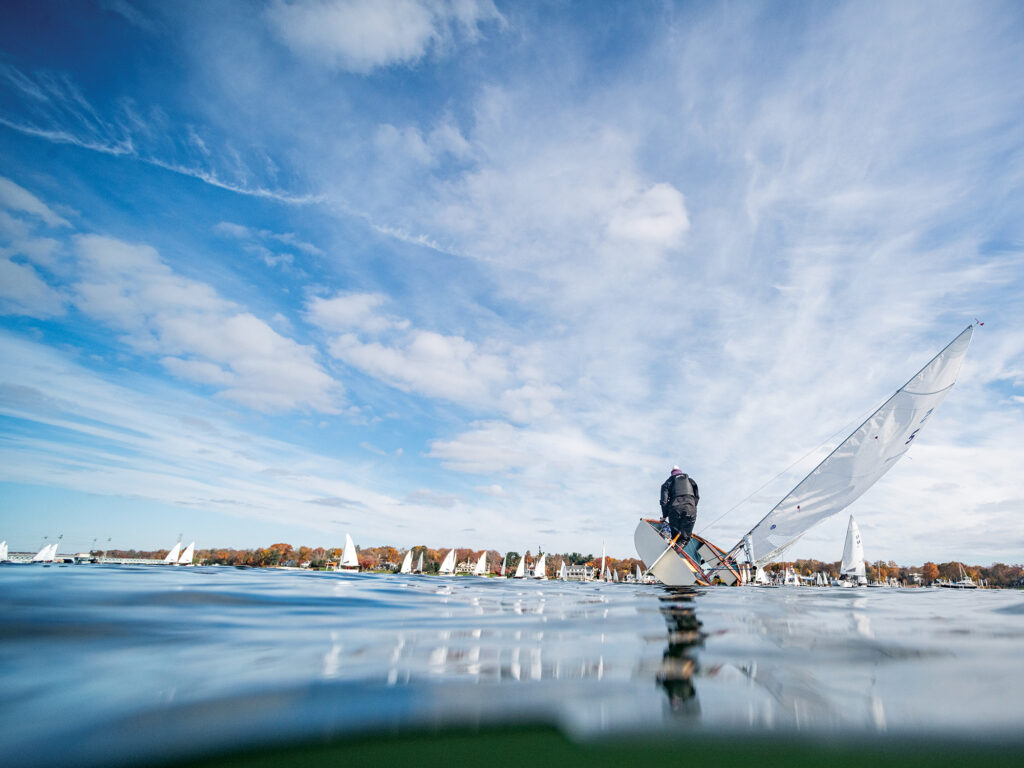
On a crisp late-November afternoon in swanky Greenwich, Connecticut, Teresa Laughlin hadn’t yet grasped the magnitude of her place in sailing history. Well, Riverside Dyer Dink history, that is.
Two hours earlier, out on the flat and swift-running waters of the shallow Cos Cob Harbor, Laughlin, a glamorous 65-year-old public relations professional from Larchmont, New York, was maneuvering her tippy 10-foot Dyer Dink in the same fashion she would her car in the rush-hour madness of nearby Interstate 95. She was fearless yet calculated as she steered her way into the pandemonium of 69 other Dinks trying to squeeze between an anchored race-committee boat and an orange flag on a buoy 100 feet away. Buried in the pileup of white dinghies near the committee boat, she instinctively tacked to escape—into the lead and into the Riverside Dyer Dinghy Association’s annals as the sailor who won the first race of the biggest frostbite championship turnout in 62 years.
“It was the first time I sailed with my compass this season,” Laughlin shares with me on the porch of Riverside Yacht Club. Inside the clubhouse, the bar is boisterous with sailors regaling stories of woes and wins after four races of sheer shifty madness. “I’m trying to get better with a compass, so I had done some readings before racing and took note of what the wind was doing. But I had a very bad start, which ended up being a blessing because I saw the windshift while I was trying to figure out what to do next and quickly flopped over.”
Her gut was right. She was the first skipper to jump the shift and “just kept getting lifted all the way to the mark.”
She had clear air and left the maelstrom of white sails in her wake.
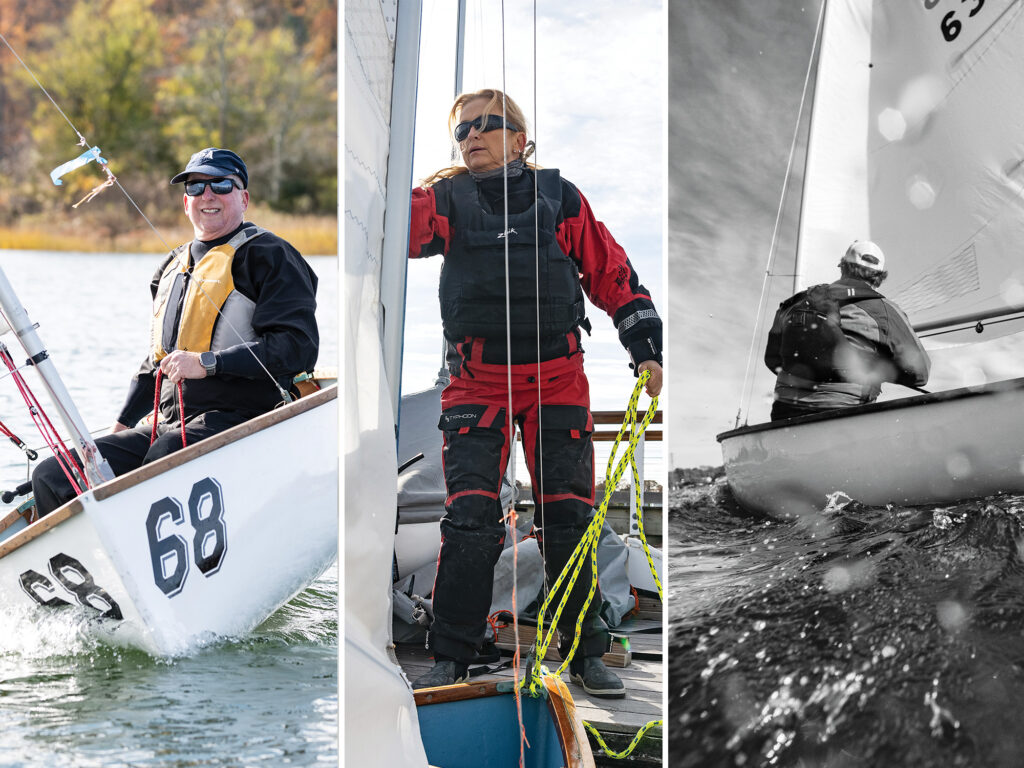
“I kept watching the other side, and I was like, Am I going to round first? And then I was like, No. And then I was like, Oh my God, I’m gonna round first.”
With a bunch of dinghy-sailing hotshots soon on her tail, Laughlin is pretty sure she spent the entire downwind leg talking herself out of a panic.
“I rounded the leeward mark first, which was beyond thrilling,” she says, “and I felt the pressure of not wanting to lose it, and then having this wall of boats coming at me, trying to navigate through them. It was very exciting, and I’m gonna put that in my brain forever.
“But it made a mess of me for the next race. I went to 59.”
That’s the thing about Riverside Dyer Dink frostbite racing—it’s as cruel and cold as it is strangely satisfying.
The remainder of Laughlin’s finishes in the day’s other races go out with the tide, while the perennial fleet champions, new and old, go tit for tat at the front of the fleet. We’re talking about 2022 season champ Jon Singsen, one of the young bloods of the Riverside Dink fleet. He’s exceptionally fast and smart, but he has a long way to go to strip 21-time frostbite fleet champion Ty Anderson of his GOAT status.
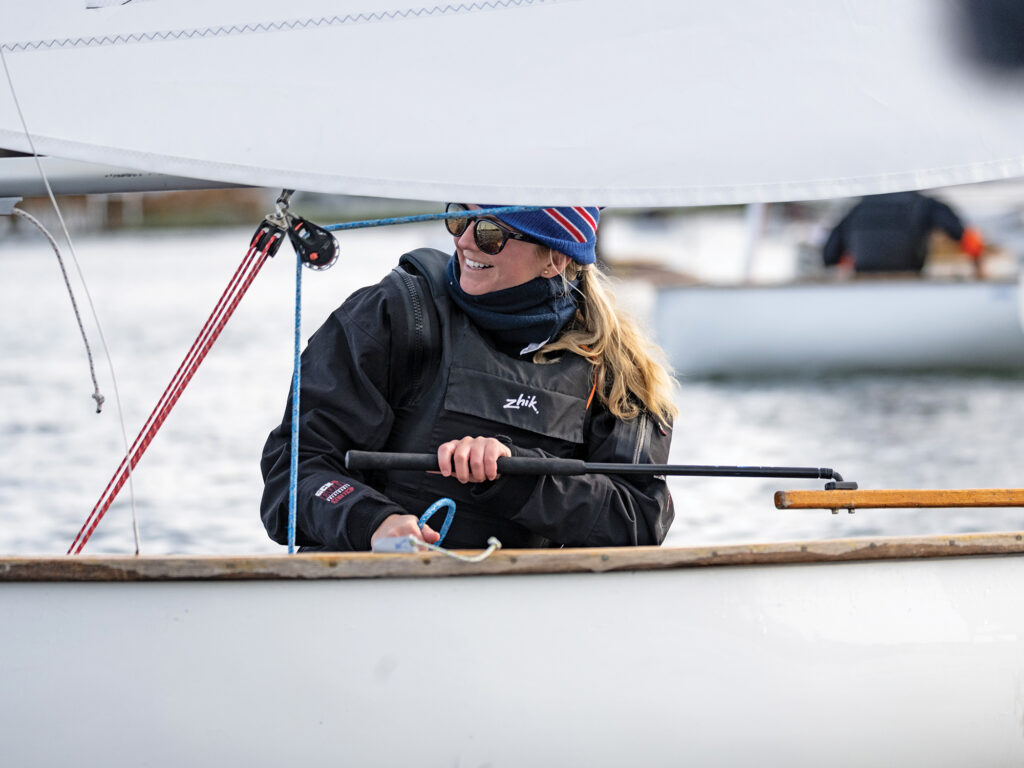
Anderson’s name first appears on the championship’s bronze trophy plaques as winner of the 1988-1999 season. After a few interruptions, he goes on a 12-season winning streak from 1995 to 2008, until a fella named Joby Breck breaks his stride. Anderson, the 66-year-old past commodore, accepts that he’s not as agile as Singsen and others, but he still makes them work for their wins.
“It took me four years to get to the top,” Anderson tells me, “and that’s typical because no one has come here and won their first year. With the subtleties of the boat and the trickiness of the harbor, you don’t just step in and win the fleet. Jon sailed for five or six years before he broke through.”
The funny thing about Singsen is that he is one of the few sailors here who doesn’t actually own one of the 95 Dinks neatly arranged on Riverside YC’s winter docks. He’s a beneficiary of the association’s allowance for skipper substitutions on a weekly basis. The simple point is to leave no boat behind. “I’m fortunate that I get to sail a lot of the different boats because the fleet is so welcoming,” Singsen says. “That helps bring people like me into it and has helped the fleet grow.”
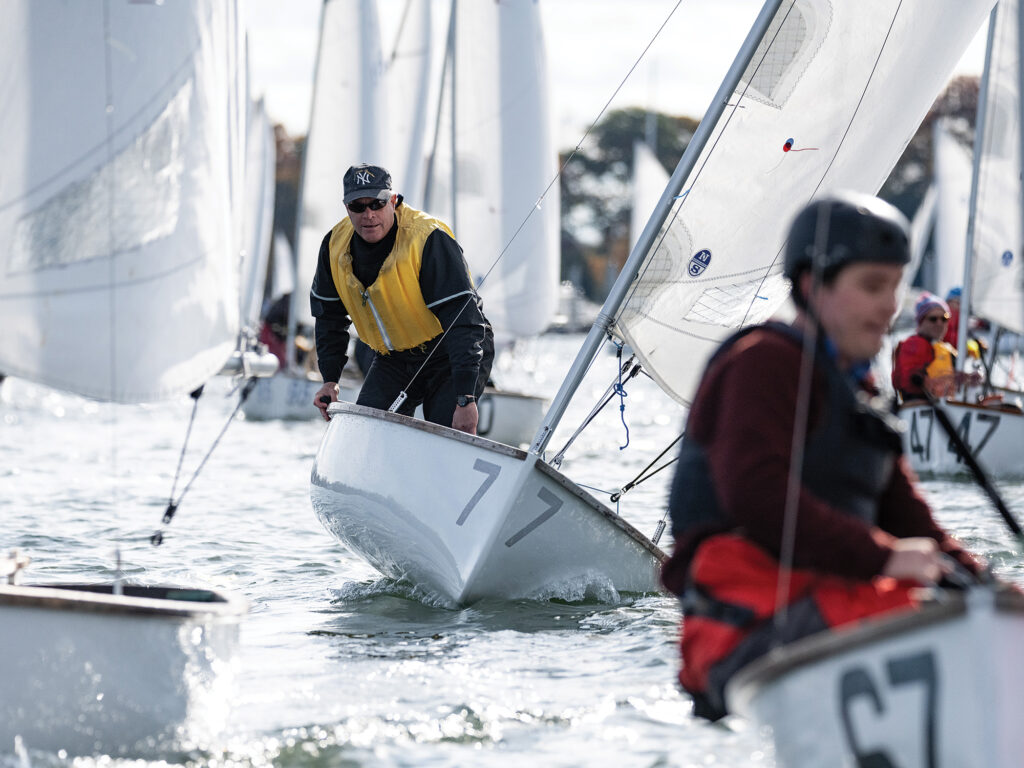
On this particular day, the fourth of the season, Singsen jumped into a boat named Hasta La Vista, Baby and knocked off an enviable string of results (7-2-15-1) that keeps him at the top of the monthslong championship scoreboard and well ahead of Anderson. The two sailors share an equal and healthy respect for each other on and off the water, with Singsen confessing that he’s learned the nuances of the Dink by watching the old master.
“Ty has been in the fleet a long time, and he keeps things pretty simple on his boat,” Singsen says. “My first couple of seasons, I watched what he did with his boathandling because I think, when it comes down to it, efficient boathandling makes a huge difference in these boats. It’s a half of a boatlength every time you maneuver, and Ty looks smooth all the time.”
Anderson, who is ninth overall for the day, is grateful of Singsen’s praise, but he dishes it right back: “Jon is now the best boathandler, and it really sets him out. The great thing about the fleet is the one-design aspect, and the fact that somebody like Jon can come in and sail a different boat every week and win the series is a wonderful endorsement of our fleet and the boats we sail.”
The Dyer Dink is still built by The Anchorage (previously Dyer Boats), three hours north in Warren, Rhode Island. The Dink is also referred to as the 10-foot Dyer, which Anderson says is distinguished from the more ubiquitous 9-foot Dyer. It was designed by Phil Rhodes in 1934 and, while they were originally wooden lapstrake hulls, fiberglass Dinks came online in the late 1940s.
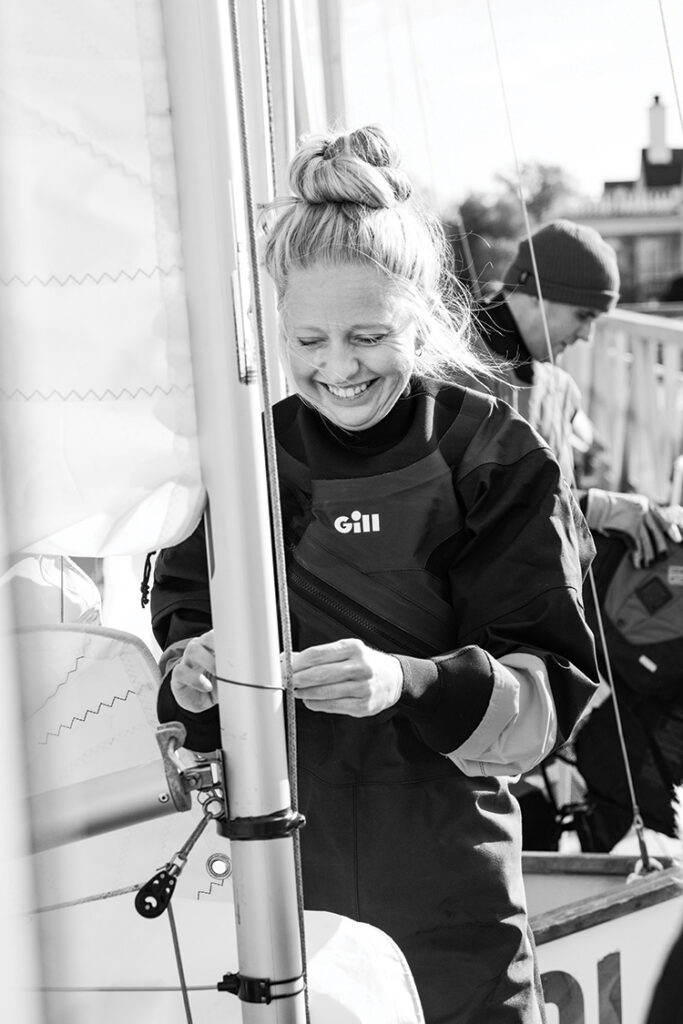
The Dink, Anderson says, is the better of the Dyer dinghies because it has “both a bow and a stern. The 9 kind of has two sterns.” The closest comparison he can draw is the Interclub, another popular frostbiting dinghy of the East Coast winter-sailing establishment. “The Dink is sort of like a singlehanded Interclub—same basic kind of hull shape and setup.”
Originally intended as a yacht tender, the Dink once had a sleeved wooden mast and overhanging boom that could be stowed inside the boat. Rigs today are aluminum, and booms have been shortened to prevent them from snagging shrouds during close ducks. And while most of the Riverside Dinks once served as rowing tenders, most oarlocks have been relegated to basement parts bins.
Before racing, Anderson shares a picture with me that he found in his basement, which he believes is from his first year in the Riverside fleet, circa 1984. When the fleet shortened the booms, it redesigned the sails with extra roach and a full-length batten. The most important change, however, was commissioning a new rudder design from renowned naval architect Bill Tripp. The original Dink rudder is more of a teardrop shape, similar to that of a Lightning rudder. The new fleet rudder is a longer high-aspect blade that now prevents a whole lot of capsizing. That is a big deal in winter sailing because despite air bags, Hippity Hop balls and other flotation aids, once a Dink is in the drink, there’s no coming back. It must be towed to the dock underwater and pumped dry.
They also now have two sail options for both ends of the wind range. “Back in the day, we still had actual reef points in the sail, so everybody would come into the clubhouse, roll up their sail, and tie it up before we went out,” Anderson says. “Now whenever we put in a fleet order of new sails, we take the old ones and cut them down so that everybody has two sails.”
Walking the docks once covers are removed reveals a lax approach to sail-control customization. It’s easy to overthink it, Anderson says. From his decades of experience, the most important customization for him is leading a double-ended vang tail to the rail, through cam cleats mounted on homemade carbon brackets—that’s his only exotic fitting, which is offset by the stainless-steel hose clamps holding his gooseneck firm to the mast.
Anderson’s entree to the fleet long ago is similar to the day’s top-three skippers: Singsen, John Bainton and Will Graves were all dinghy and college sailors who settled in the area and found a welcoming and familiar scene at Riverside. “Frostbiting became my sailing outlet after college,” Anderson says, “which it does for a lot of people because frostbiting is so very similar to college sailing: It’s small boats, small bodies of water, shifty breeze, crowded marks, stuff like that. It’s the same, but there’s just less swearing.”
The true skill of a Dyer champ, he adds, is one’s nimbleness. “When the younger college-sailing types show up, they’re fighting it out of the pin, and they’re very good with stopping and starting, accelerating, and changing speed and direction.”
What’s also appealing is the short time commitment on any given Sunday. Because the boats are stored on the dock with masts up, it’s as simple as peeling back the cover, hoisting the sail, dropping the rudder into the pintels, and sailing to the racecourse 200 feet or so from the dock. With such a shallow race area, the tide dictates their sailing window; they start at either 10 a.m. or 2 p.m., and have a hard stop after two hours.
“This is far and away the best sailing year-round,” says Graves, an investment officer in New York City and a two-time All-American at the US Naval Academy. He’s also one of Singsen’s weekly threats. His boat is dialed in, and yoga keeps him fit enough to endure two hours of careful footsteps and Crouching Tiger stances in the boat when it’s light.
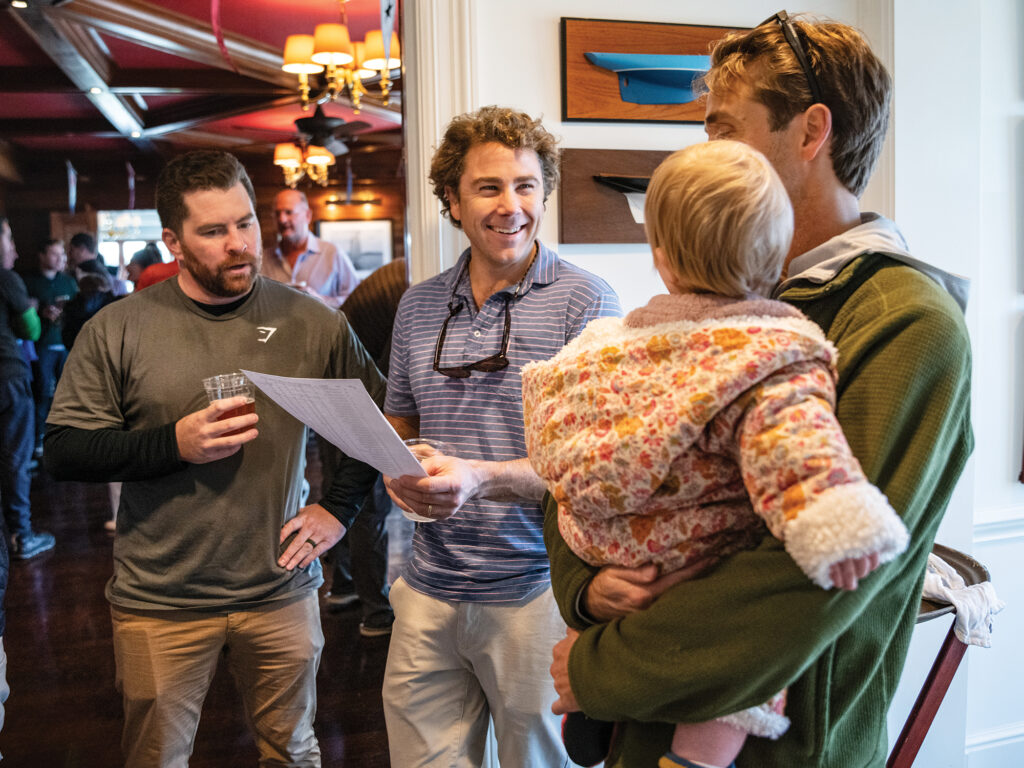
“I’m amazed at how sore I feel on a Monday morning,” Graves says. “It’s the awkward sitting, the crouching, and the constant movement. There is a fair bit of physicality to it, and it is just superior college-style racing that sucks you right in. It’s two hours of total separation from life—really magical.”
Graves hunted for a good Dink for a while before scoring one a few years ago. They go pretty quickly, he says, but he was able to get his hands on a light five-year-old hull. “The boats are really simple, so it’s just a matter getting sail controls led to the skipper and close enough on weight, and with that the fleet does a great job with corrector weights.”
One entourage in the fleet who don’t require corrector weights is a band of big fellas who call themselves The Slayers. They take great pride in being too big for the boat. “We’re a group of overweight, underskilled sailors, and when you’re in a big fleet like this, you actually need to have another competition; otherwise, it gets boring being at the back of the fleet,” Tom Jankovich says. “We have rules that only we know and no one at the top of the fleet knows. Those rules focus on how can the fat guys win and the fast guys not win.”
With a weekly gathering of such size, it does take a local army to pull off the racing. “It takes a ton of volunteers to make it happen every day,” fleet co-captain Bobby Pruett tells me. “We have about 18 race committee on crash boats, mark boats, whatever it may be, each and every Sunday between October through March, so it’s a big lift to make the opportunity to race with everyone happen.”
Pruett’s journey from New York City’s West Village to Riverside YC each weekend is epic unto itself: “It’s about an hour and a half commute. If it’s a 2 o’clock start, I’m hopping on the BDFM [New York Subway] to take the shuttle across, then to Grand Central, then Metro North, then to my sister’s house to pick up my moped to get to the club.”
But it’s absolutely worth the journey, he says.
Pruett’s co-captain Kevin Kelley had not raced a dinghy until 10 years ago. When he moved to Riverside, he quickly discovered that Dink racing was where the offseason action was at. “We now have 95 boats on the dock, and when I was looking for a boat, there were more new members than there were new boats, so I had to buy a new one,” he says. “Two decades ago, I understand the biggest challenge was getting people to sign up. Now the biggest challenge is fitting them all on the dock space we have.”
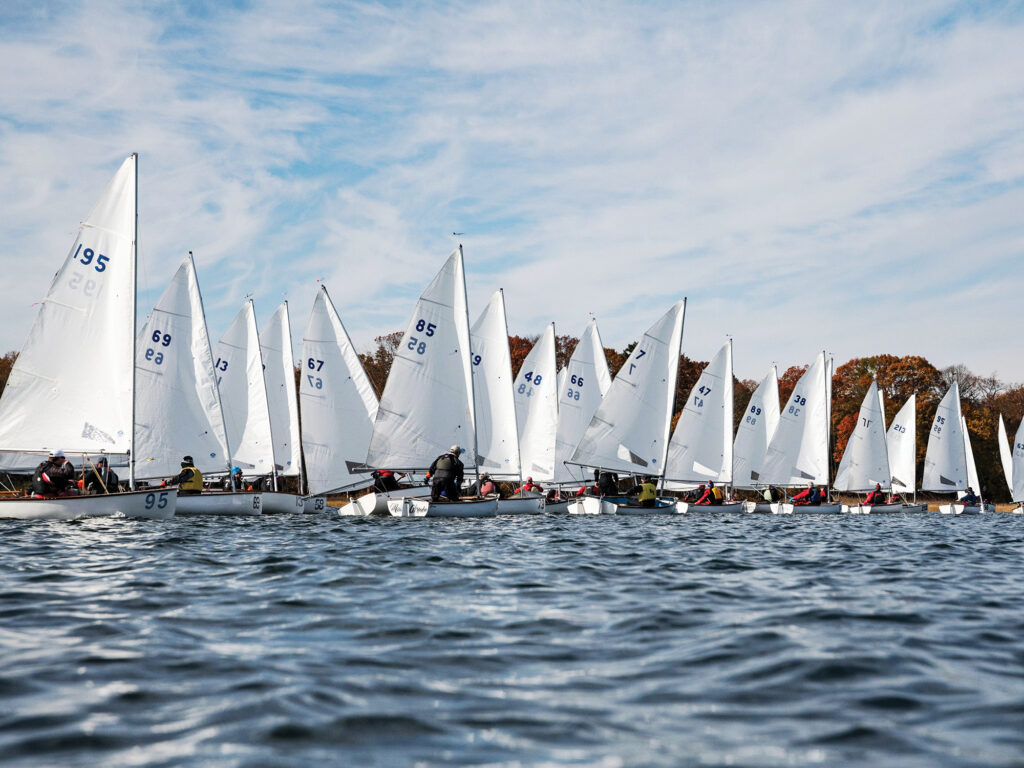
Clearly, this crowd is into the Dink thing, and while the racing is over in a blink, the pace of derigging on the dock is as brisk as I’ve ever seen. It’s barely past noon, and in a rush, sails are rolled and covers zipped, and there’s a beeline to the bar where Pruett shares good news over chili, beer, and properly mixed Dark ‘n Stormy cocktails served in proper-size pint glasses.
He gathers the sailors in a small side room in the club, where the perpetual trophy hangs in a corner by the window.
“There were a total of 70 boats today,” he says once the crowd is hushed with whistles. “Initially, I was given wrong information that the record was 71. Well, it was 64, so we have the record. We got it done.”
The sailors cheer, finish their drinks, and slip away to domestic chores, afternoon football games, trains to the city, and naps. It’s been a proper day of frostbite Dink racing, and they’ll be back again next Sunday for their weekly fix.









